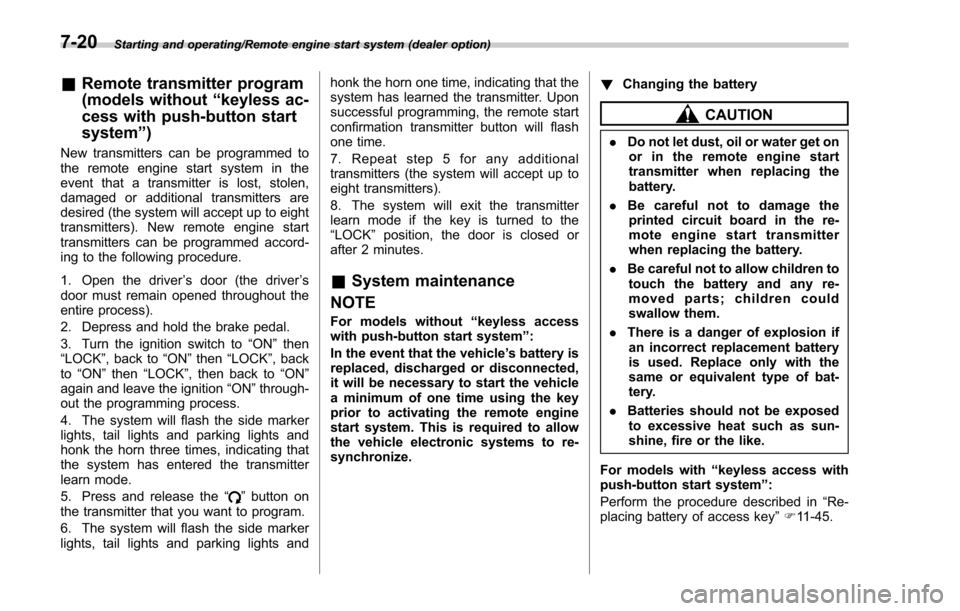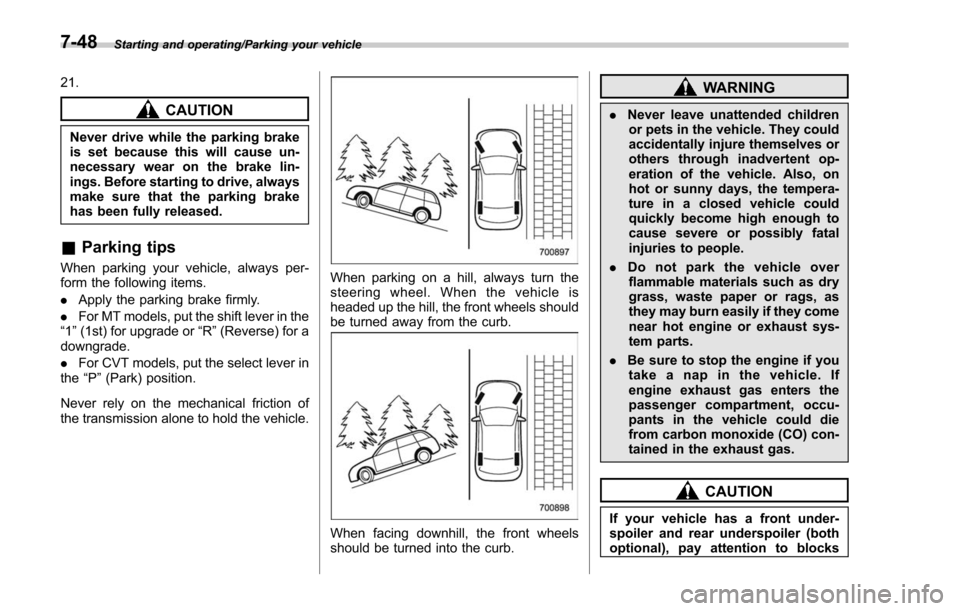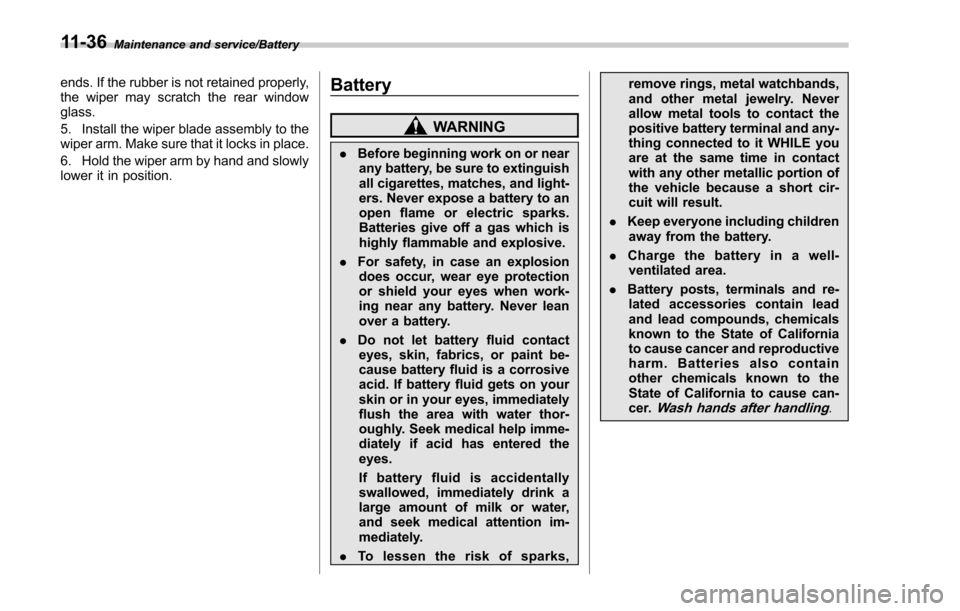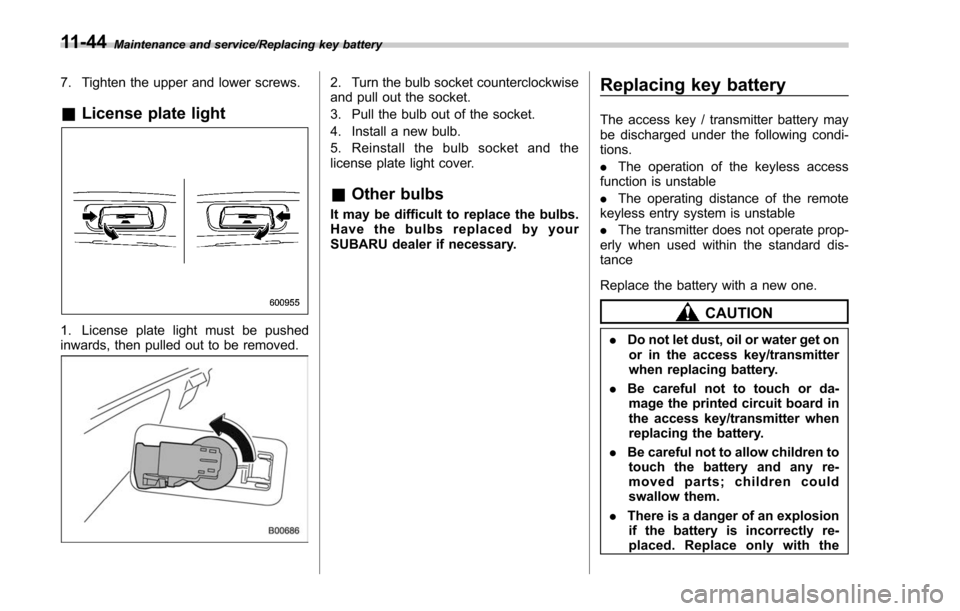2017 SUBARU FORESTER child lock
[x] Cancel search: child lockPage 155 of 634

Instruments and controls/Ignition switch (models without push–button start system)
Ignition switch (models with-
out push-button start sys-
tem)
WARNING
. Never turn the ignition switch to
the “LOCK ”position while the
vehicle is being driven or towed
because that will lock the steer-
ing wheel, preventing steering
control. And when the engine is
turned off, it takes a much great-
er effort than usual to steer.
. Before leaving the vehicle, al-
ways remove the key from the
ignition switch for safety and
never allow an unattended child
to remain in the vehicle. Failure
to follow this procedure could
result in injury to a child or
others. Children could operate
the power windows, the moon-
roof or other controls or even
make the vehicle move.
CAUTION
Do not attach a large key holder or
key case to either key. If it banged
against your knees or hands while
you are driving, it could turn the
ignition switch from the “ON ”posi-
tion to the “ACC ”or “LOCK ”posi-
tion, thereby stopping the engine.
Also, if the key is attached to a
keyholder or to a large bunch of
other keys, centrifugal force may act
on it as the vehicle moves, resulting
in unwanted turning of the ignition
switch.
The ignition switch has four positions:
LOCK, ACC, ON and START.
NOTE
. Keep the ignition switch in the
“ LOCK ”position when the engine is
not running.
. Using electrical accessories for a
long time with the ignition switch in the
“ ON ”or “ACC ”position can cause the
battery to go dead.
. If the ignition switch will not move
from the “LOCK ”position to the “ACC ”
position, turn the steering wheel
slightly to the left and right as you turn
the ignition switch.
& LOCK
The key can only be inserted or removed
in this position. The ignition switch will lock
the steering wheel when you remove the
key.
If turning the key is difficult, turn the
steering wheel slightly to the right and left
as you turn the key.
3-4
Page 166 of 634

operation that follows the 6-second
warning after turning ON the ignition
switch. When the ignition switch is
turned ON next time, however, the
complete sequence of the warning
operation resumes. For further details
about canceling the warning operation,
please contact your SUBARU dealer.
If there is no passenger on the front
passenger’s seat, the seatbelt warning
device for the front passenger ’s seat will
be deactivated. The front passenger ’s
occupant detection system monitors
whether or not there is a passenger on
the front passenger ’s seat.
Observe the following precautions. Failure
to do so may prevent the device from
functioning correctly or cause the device
to fail.
. Do not install any accessory such as a
table or TV onto the seatback.
. Do not store a heavy load in the
seatback pocket.
. Do not allow the rear seat occupant to
place his/her hands or legs on the front
passenger ’s seatback, or allow him/her to
pull the seatback.
. Do not use front seats with their back-
ward-forward position and seatback not
being locked into place securely. If any of
them are not locked securely, adjust them again. For adjusting procedure, refer to
“Front seats
”F 1-2.
If the seatbelt warning device for the front
passenger ’s seat does not function cor-
rectly (e.g., it is activated even when the
front passenger ’s seat is empty or it is
deactivated even when the front passen-
ger has not fastened his/her seatbelt),
take the following actions.
. Ensure that no article is placed on the
seat other than a child restraint system
and its child occupant, although we
strongly recommend that all children sit
in the rear seat properly restrained.
. Ensure that there is no article left in the
seatback pocket.
. Ensure that the backward-forward po-
sition and seatback of front passenger ’s
seat are locked into place securely by
moving the seat back and forth.
If still the seatbelt warning device for front
passenger ’s seat does not function cor-
rectly after taking relevant corrective ac-
tions described above, immediately con-
tact your SUBARU dealer for an inspec-
tion.&SRS airbag system
warning light
WARNING
If the warning light exhibits any of
the following conditions, there may
be a malfunction in the seatbelt
pretensioners and/or SRS airbag
system. Immediately take your vehi-
cle to your nearest SUBARU dealer
to have the system checked. Unless
checked and properly repaired, the
seatbelt pretensioners and/or SRS
airbag will not operate properly in
the event of a collision, which may
increase the risk of injury.
. Flashing or flickering of the warn-
ing light
. No illumination of the warning
light when the ignition switch is
first turned to the “ON ”position
. Continuous illumination of the
warning light
. Illumination of the warning light
while driving
For more details about the SRS airbag
system warning light, refer to “SRS airbag
system monitors ”F 1-69.
Instruments and controls/Warning and indicator lights
–CONTINUED –3-15
Page 423 of 634

Starting and operating/Remote engine start system (dealer option)
&Remote transmitter program
(models without “keyless ac-
cess with push-button start
system ”)
New transmitters can be programmed to
the remote engine start system in the
event that a transmitter is lost, stolen,
damaged or additional transmitters are
desired (the system will accept up to eight
transmitters). New remote engine start
transmitters can be programmed accord-
ing to the following procedure.
1. Open the driver ’s door (the driver ’s
door must remain opened throughout the
entire process).
2. Depress and hold the brake pedal.
3. Turn the ignition switch to “ON”then
“LOCK” , back to “ON”then “LOCK ”, back
to “ON ”then “LOCK”, then back to “ON”
again and leave the ignition “ON”through-
out the programming process.
4. The system will flash the side marker
lights, tail lights and parking lights and
honk the horn three times, indicating that
the system has entered the transmitter
learn mode.
5. Press and release the “
”button on
the transmitter that you want to program.
6. The system will flash the side marker
lights, tail lights and parking lights and honk the horn one time, indicating that the
system has learned the transmitter. Upon
successful programming, the remote start
confirmation transmitter button will flash
one time.
7. Repeat step 5 for any additional
transmitters (the system will accept up to
eight transmitters).
8. The system will exit the transmitter
learn mode if the key is turned to the
“LOCK”
position, the door is closed or
after 2 minutes.
& System maintenance
NOTE
For models without “keyless access
with push-button start system ”:
In the event that the vehicle ’s battery is
replaced, discharged or disconnected,
it will be necessary to start the vehicle
a minimum of one time using the key
prior to activating the remote engine
start system. This is required to allow
the vehicle electronic systems to re-
synchronize. !
Changing the battery
CAUTION
.Do not let dust, oil or water get on
or in the remote engine start
transmitter when replacing the
battery.
. Be careful not to damage the
printed circuit board in the re-
mote engine start transmitter
when replacing the battery.
. Be careful not to allow children to
touch the battery and any re-
moved parts; children could
swallow them.
. There is a danger of explosion if
an incorrect replacement battery
is used. Replace only with the
same or equivalent type of bat-
tery.
. Batteries should not be exposed
to excessive heat such as sun-
shine, fire or the like.
For models with “keyless access with
push-button start system ”:
Perform the procedure described in “Re-
placing battery of access key ”F 11-45.
7-20
Page 451 of 634

Starting and operating/Parking your vehicle
21.
CAUTION
Never drive while the parking brake
is set because this will cause un-
necessary wear on the brake lin-
ings. Before starting to drive, always
make sure that the parking brake
has been fully released.
&Parking tips
When parking your vehicle, always per-
form the following items.
. Apply the parking brake firmly.
. For MT models, put the shift lever in the
“1 ”(1st) for upgrade or “R”(Reverse) for a
downgrade.
. For CVT models, put the select lever in
the “P”(Park) position.
Never rely on the mechanical friction of
the transmission alone to hold the vehicle.When parking on a hill, always turn the
steering wheel. When the vehicle is
headed up the hill, the front wheels should
be turned away from the curb.
When facing downhill, the front wheels
should be turned into the curb.
WARNING
. Never leave unattended children
or pets in the vehicle. They could
accidentally injure themselves or
others through inadvertent op-
eration of the vehicle. Also, on
hot or sunny days, the tempera-
ture in a closed vehicle could
quickly become high enough to
cause severe or possibly fatal
injuries to people.
. Do not park the vehicle over
flammable materials such as dry
grass, waste paper or rags, as
they may burn easily if they come
near hot engine or exhaust sys-
tem parts.
. Be sure to stop the engine if you
take a nap in the vehicle. If
engine exhaust gas enters the
passenger compartment, occu-
pants in the vehicle could die
from carbon monoxide (CO) con-
tained in the exhaust gas.
CAUTION
If your vehicle has a front under-
spoiler and rear underspoiler (both
optional), pay attention to blocks
7-48
Page 567 of 634

Maintenance and service/Battery
ends. If the rubber is not retained properly,
the wiper may scratch the rear window
glass.
5. Install the wiper blade assembly to the
wiper arm. Make sure that it locks in place.
6. Hold the wiper arm by hand and slowly
lower it in position.Battery
WARNING
.Before beginning work on or near
any battery, be sure to extinguish
all cigarettes, matches, and light-
ers. Never expose a battery to an
open flame or electric sparks.
Batteries give off a gas which is
highly flammable and explosive.
. For safety, in case an explosion
does occur, wear eye protection
or shield your eyes when work-
ing near any battery. Never lean
over a battery.
. Do not let battery fluid contact
eyes, skin, fabrics, or paint be-
cause battery fluid is a corrosive
acid. If battery fluid gets on your
skin or in your eyes, immediately
flush the area with water thor-
oughly. Seek medical help imme-
diately if acid has entered the
eyes.
If battery fluid is accidentally
swallowed, immediately drink a
large amount of milk or water,
and seek medical attention im-
mediately.
. To lessen the risk of sparks, remove rings, metal watchbands,
and other metal jewelry. Never
allow metal tools to contact the
positive battery terminal and any-
thing connected to it WHILE you
are at the same time in contact
with any other metallic portion of
the vehicle because a short cir-
cuit will result.
. Keep everyone including children
away from the battery.
. Charge the battery in a well-
ventilated area.
. Battery posts, terminals and re-
lated accessories contain lead
and lead compounds, chemicals
known to the State of California
to cause cancer and reproductive
harm. Batteries also contain
other chemicals known to the
State of California to cause can-
cer.
Wash hands after handling.
11-36
Page 575 of 634

Maintenance and service/Replacing key battery
7. Tighten the upper and lower screws.
&License plate light
1. License plate light must be pushed
inwards, then pulled out to be removed.
2. Turn the bulb socket counterclockwise
and pull out the socket.
3. Pull the bulb out of the socket.
4. Install a new bulb.
5. Reinstall the bulb socket and the
license plate light cover.
&Other bulbs
It may be difficult to replace the bulbs.
Have the bulbs replaced by your
SUBARU dealer if necessary.
Replacing key battery
The access key / transmitter battery may
be discharged under the following condi-
tions.
. The operation of the keyless access
function is unstable
. The operating distance of the remote
keyless entry system is unstable
. The transmitter does not operate prop-
erly when used within the standard dis-
tance
Replace the battery with a new one.
CAUTION
. Do not let dust, oil or water get on
or in the access key/transmitter
when replacing battery.
. Be careful not to touch or da-
mage the printed circuit board in
the access key/transmitter when
replacing the battery.
. Be careful not to allow children to
touch the battery and any re-
moved parts; children could
swallow them.
. There is a danger of an explosion
if the battery is incorrectly re-
placed. Replace only with the
11-44
Page 618 of 634

Bottle holder................................................................ 6-9
Brake Assist ................................................................... 7-36
Booster ........................................................ 7-36, 11-20
Disc .................................................................... 12-11
Fluid ............................................................ 11-18, 12-9
Pad and lining ...................................................... 11-22
Parking ........................................................ 7-47, 11-23
Pedal .................................................................. 11-20
System ................................................................. 7-36
Brake pedal Free play ............................................................. 11-20
Reserve distance .................................................. 11-20
Brake system ............................................................ 7-36
Warning light ......................................................... 3-21
Braking ..................................................................... 7-35
Tips...................................................................... 7-35
Breaking-in of new brake pads and linings ................... 11-22
BSD/RCTA ................................................................ 7-58
Approach indicator light/warning buzzer .................... 7-61
OFF indicator ................................................ 3-34, 7-64
OFF switch ........................................................... 7-64
Warning indicator ........................................... 3-33, 7-63
Warning volume ............................................. 3-43, 7-62
Bulb Chart .................................................................. 12-16
Replacing ............................................................. 11-39
C
Cargo area Cover ................................................................... 6-14 Light
...................................................................... 6-2
Tie-down hooks ...................................................... 6-16
Catalytic converter ....................................................... 8-3
Center console ............................................................ 6-6
Changing Coolant ............................................................... 11-14
Flat tire .................................................................. 9-5
Oil and oil filter ..................................................... 11-11
Charge warning light ................................................... 3-18
CHECK ENGINE warning light/Malfunction indicator light ....................................................................... 3-16
Checking Brake pedal free play ............................................ 11-20
Brake pedal reserve distance ................................. 11-20
Clutch function ..................................................... 11-21
Clutch pedal free play ........................................... 11-21
Coolant level ........................................................ 11-13
Fluid level (brake fluid) .......................................... 11-18
Fluid level (clutch fluid) .......................................... 11-19
Fluid level (washer fluid) ........................................ 11-30
Oil level (engine oil) .............................................. 11-10
Child restraint systems ................................................ 1-29
Installation of a booster seat .................................... 1-36
Installation with ALR/ELR seatbelt ............................ 1-32
Lower and tether anchorages ................................... 1-37
Top tether anchorages ............................................
1-40
Child safety ................................................................... 4
Locks .................................................................... 2-32
Chime
Key........................................................................\
3-5
Light ..................................................................... 3-93
Index14-3
Page 625 of 634

14-10Index
Immobilizer.............................................................. 2-3
Indicator light ......................................................... 3-30
Shock sensors ....................................................... 2-31
Select lever Position indicator ................................................... 3-31
Shift lock function ................................................... 7-30
Shock sensors ........................................................... 2-31
Shopping bag hook .................................................... 6-13
Shoulder pretensioners ............................................... 1-25
SI-DRIVE .................................................................. 7-32
Indicator light ......................................................... 3-31
Snow tires ........................................................ 8-11, 11-23
Snowy and icy roads .................................................. 8-10
Sounding a panic alarm .............................................. 2-24
Spark plugs .................................................... 11-16, 12-10
Specifications ............................................................ 12-2
Speedometer ............................................................. 3-10
SRS Curtain airbag ........................................................ 1-61
Frontal airbag ........................................................ 1-51
Side airbag ........................................................... 1-61
SRS airbag (Supplemental Restraint System airbag) ... 4, 1-42
SRS airbag system Monitors. ............................................................... 1-69
Servicing ............................................................... 1-71
Warning light ......................................................... 3-15
Starting & stopping engine .................................... 7-9, 7-12
State emission testing (U.S. only) .................................. 7-7
Steering responsive fog lights system ......................... 3-103
OFF indicator ........................................................ 3-33
Warning indicator ................................................... 3-33 Steering Responsive Headlight
..................................... 3-99
Steering switches for audio .......................................... 5-62
Steering wheel
Heated Steering Wheel system .............................. 3-119
Power ................................................................... 7-34
Tilt/telescopic ....................................................... 3-118
Stop light ................................................................. 11-42
Storage compartment ................................................... 6-6
Sun shade ................................................................. 2-47
Sun visors .................................................................. 6-4
Supplemental Restraint System airbag (SRS) ................ 1-42
Synthetic leather upholstery ......................................... 10-6
T
Tachometer ................................................................ 3-11
Temperature warning light AT OIL TEMP ......................................................... 3-19
Coolant ................................................................. 3-17
Temporary spare tire .................................................... 9-2
Tether (child restraint system) .............................. 1-37, 1-40
Tie-down hooks .......................................................... 9-13
Tire Chains .................................................................. 8-11
Inspection ............................................................ 11-25
Pressures and wear .............................................. 11-25
Replacement. .......................................................
11-29
Rotation .............................................................. 11-28
Size and pressure ................................................ 12-10
Types .................................................................. 11-23
Tire pressure monitoring system (TPMS) ....... 7-46, 9-8, 11-23
Warning light .......................................................... 3-19